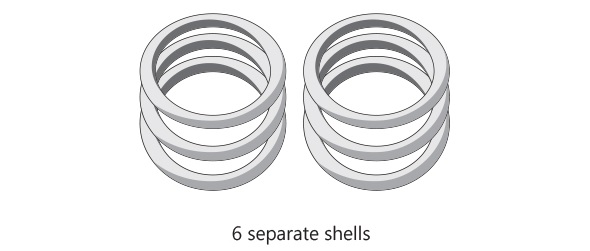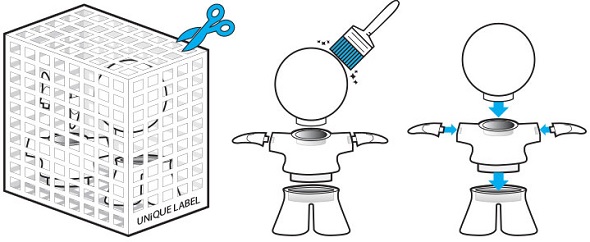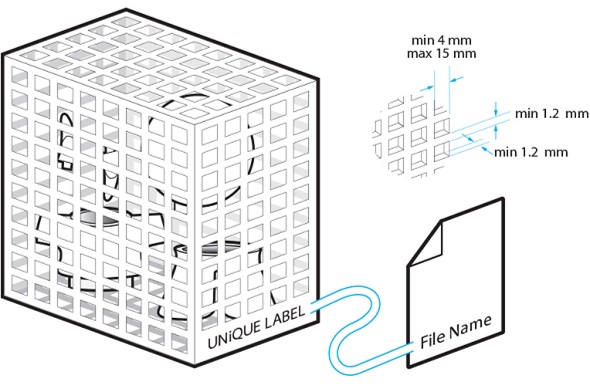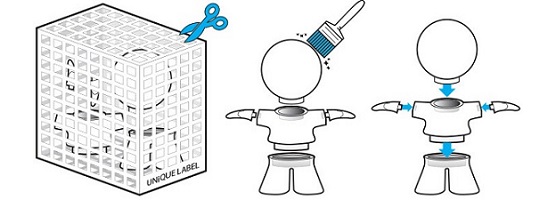
How to 3D Print ‘Grouped Models’ by Using a Grid Container
In this blog post you will learn how to order so called ‘grouped models’ by putting them in a grid container. Using a grid container will not only let you upload several 3D models at once but it will also help you to save money.
What are grouped models?
Grouped models are two or more models that are saved within one 3D file. Although there is nothing wrong with having more than one model in a file while designing, we cannot use these designs for 3D printing.
For example, users that upload the following design with six separate shells will get a notification that their order will be cancelled.
Why can grouped models not be printed?
One of the reasons behind this are the fixed handling costs per model. For every 3D model that gets ordered, we need to look into the design, check it for printability, and finally clean, finish and quality check the print after the production process. This is why we typically charge markups for every 3D print.
The second reason behind this is that if users upload ‘grouped models’ there would be confusion in our production facility about which prints belong to which customer, as our system only tracks one file at a time.
The simple solution for grouping models the right way: A grid container
For Polyamide and Alumide the best option that will allow you to print multiple shells in one go is to place all of your parts into a container. This means that you will need to design a container around your parts and let them ‘flow’ in there. Once you receive your 3D print you can cut the box open, clean the parts and assemble the model (see images below).
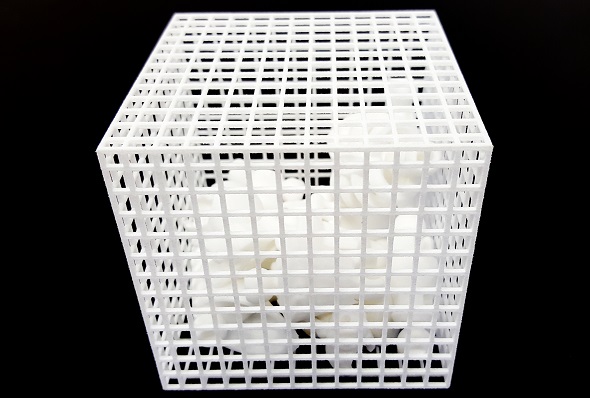
This is what a 3D printed ‘grouped model’ in a box container looks like.
- Downside: This technique will not allow us to make accurate quality inspections, to provide optimal cleaning of each part by our production team nor to pack and protect each individual part in the best way for shipment. Grouped models are only offered in the natural finish. Choosing a grid container option implies that you accept these conditions and don’t mind getting your hands dirty to do some extra cleaning of your parts. In addition, grid containers are only available for polyamide and alumide.
- Upside: You will only be paying one markup cost for the entire print. Putting many small objects in a grid container will reduce 3D printing costs dramatically.
How do I design a grid container?
Here are some basic things to take into account when designing that container.
- Always engrave your container with a unique label identical to the filename of your design so we can easily identify your box, as we won’t be able to check the contents of your container.
- It is advised to use a perforated container because that will allow us to remove most of the excessive powder from your parts. We recommend the following minimum feature sizes for your container: at least a 1.2 mm thickness for the grid lines; and a minimum perforation of a 4 x 4 mm square up to a maximum of 15 x 15 mm. Make sure the parts inside your container cannot pass through the perforations of the container, to ensure that all your parts stay together. Parts that can pass through the holes might get lost.
- In addition to your container features, you also need to keep a minimum spacing distance of 3 mm between each individual part and between the sides of the container and the parts. If the distance is smaller than this, parts might get sintered together.
- If the overall volume of your container is larger than 1700 cm3, you should limit the density in the container because parts that are too dense can cause an irregular cooling down process. This may cause yellowing and deformation of your parts. Limit the total volume of the models to 10% of the overall volume of the container.
- If you have fragile parts in the container, we recommend connecting the individual parts to the container. This will prevent fragile parts from hitting each other during shipment. Otherwise, your parts will be loose in the closed container and may damage each other by moving around during the shipping process.
Upload your models in a grid container
So do you want to order ‘grouped models’ in a grid container? Find more information about this and upload your container on our dedicated ‘Grid Container page’. Want to learn more about reducing 3D printing costs? Read about our ‘#1 Hack to make your 3D print cheaper’.
Recommended Articles
No related posts.


